|
Toronto Recording Artists On Radio
Part One
by Arthur E. Zimmerman
Ferdinand Fillion standing before the small receiving horn in the CITCo
studio, top floor of the new GE factory, "playing to invisible thousands separated by
miles of empty air". He was in the middle of the last number on the second Toronto Star
program, Fritz Kreisler's "Viennese Popular Song". Miss Mary MacKinnon was at the piano.
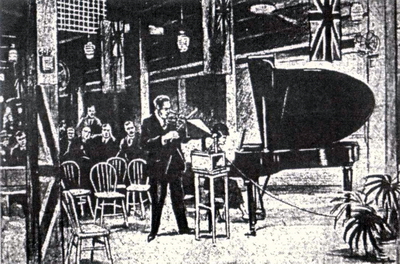
|
|
9AH......... 9AH........ JAH........ This is 9AH,
the broadcasting station of the Canadian
Independent Telephone Company, Toronto,
Canada.....QST........0ST.......... Tune up to 450 for
The Toronto Star radio concert.
The announcer was Dr. Charles Aaron
Culver, Chief High Frequency Engineer of
the Canadian Independent Telephone
Company (CITCo). Sitting in front of a little boxy
wooden horn in the cafeteria on the fourth floor of
the new Canadian General Electric factory at Ward
Street and Wallace Avenue, he announced that this
wireless telephone concert was being put on as a
demonstration by The Toronto Daily Star.
Dr. Culver repeated the call letters and the
announcements several times, to allow the few
amateurs and pioneering radio broadcast listeners
in the district to adjust their receivers to 450
metres before the concert began.
For years the Star had presented weekly series of
free public concerts around Toronto, the programs
managed by The Star critic (Augustus Bridle?) and
featuring the wealth of musical talent in Toronto:
music teachers, advanced students, church soloists
and instrumental ensembles. The venture into radio
was an exciting experimental leap for the
newspaper,to use the new and still imperfect
wireless telephone to transmit these Star
demonstration concerts to a wider public.
Delivering concerts broad-cast through the ether
was still a new, daring concept that was just
catching on in the United States, for this was just
at the beginning of the radio boom. Preparations
for the debut wireless telephone concert had been
made in secret. The Starís announcement wasnít
published until March 27, 1922,just the day before
the big event.
Dr. Charles A. Culver,
CITCo's high frequency radio engineer,
making the opening announcements forthe first Toronto Star
radio concert demonstration. He is speaking into the
"receiver" or "transmitter" and a box, probably containing the microphone
amplifier, is on the floor behind the desk. Below, Mrs. R.J.
Dilworth is singing into the "receiver" and Mrs. Evelyn Chelew
Kemp is at the piano.
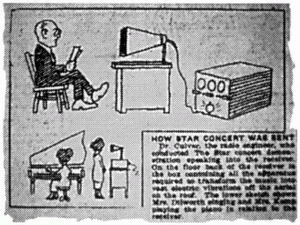
|
|
In this first series of Toronto Star radio concerts,
broadcast over CITCOís 9AH (later CKCE, before
the opening of The Toronto Star station CFCA),
many of the artists had already or were soon to
make gramophone recordings, often in Montreal.
Toronto had no recording studios.
There were perhaps a thousand wireless amateurs
in and around Toronto who could pick up the
broadcast, and many people still did not believe
that sound could be transmitted through the ether
without wires, so the newspaper arranged for the
demonstration to be heard in public auditoriums as
well. One was at the Masonic Temple at
Davenport and Yonge and a second was for the
veterans and the nursing sisters at the Christie
Street Military Hospital. The Masonic Temple was
jammed minutes after the doors opened and
hundreds were left out on the street. The young
Edward S. "Ted" Rogers was a CITCo employee
around that time and may have assisted technically
at one of the three locations.
The artists were asked by Dr. Culver to be
punctual in starting their respective numbers.
"Itís a peculiar thing," he explained, "that
radio audiences of an invisible kind are very
impatient."
"Stand by," broadcasted Dr. Culver at half-
past eight....... "The first number on the
program" .....the National Anthem played by
Mrs. Evelyn Chelew Kemp...... "Number two
on the program furnished by The Toronto
Daily Star" Mrs. RJ. Dilworth singing
"Down in the Forest." Every number was
announced by Dr. Culver, speaking into the
magic horn in a slow, distinct voice.
Leslie Allen (1902-96),
one of the first saxophonists in
Toronto,
circa 1922.
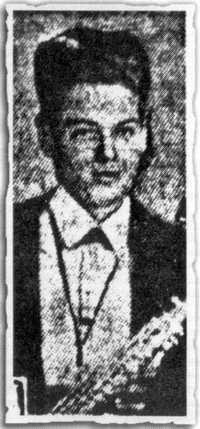
|
|
The inaugural experimental radio concert gathered
together some of the best Toronto artists. Luigi
Romanelliís Orchestra starred on that first
transmission, fresh from a successful "Jazz Week"
at the Allen Theatre in downtown Toronto.
Romanelliís Jazz Musikers played a "Popular
Medley of Syncopated Harmony": "The Sheik";
"Oh Me, Oh My"; "Sweet Hortense"; "Wabash
Blues"; "Say It With Music"; "If Winter Comes"
and "Moonlight Serenade". The history books say
that Romanelliís Orchestra was the first to
broadcast "live" in Canada, in 1922, over The
Toronto Star station CFCA. In fact, the first was
this very broadcast over 9AH, CITCoís
experimental 9-call, and a sort of grandparent of
CFCA. Romanelliís Orchestra recorded for
Berlinerís HMV label in 1922 and for RCA
Bluebird around 1940.
"What does it feel like," The Star asked
Romanelli, "to play jazz into space?"
"Quite a sensation,Ē said Mr. Romanelli.
"As I understand it, weíve just been
filling the whole of central Ontario with
Jazz, only the only ones who know it
are those who have listening sets. Jazz,
might say, is spreading, eh; spreading!"
Victor artist Boris Hambourg, cello, Director of
the Hambourg Conservatory, did a solo turn on
this first concert, playing "The Swan". He was
later the cellist of the world famous Hart House
String: Quartet (1923-1946), which also recorded
for Victor and for RCA.
Pianist Alberto Guerrero, who supposedly made
some home recordings with his young pupil,
Glenn Gould, played a piece by Liszt. Recordings
of his artistry might survive in the CBC Archives.
Assisting on that program were the unrecorded
Mrs. Dilworth, soprano, the well-known Mrs.
Kemp, piano (former pupil of patriarch Michael
Hambourg), Victor Edmunds, tenor, and the
notorious Henri Czaplinski, violin soloist and
teacher (an Auer pupil).
At the close of the concert Dr. Culver simply
said into the funnel receiver: "This is YAH
signing off". And after repeating this and
giving again the information as to what the
concert was, for the benefit of any who
might have tuned in in the middle of the
concert, he said, into space, to thousands:
"Good night!"
The second concert from the CITCo plant at Ward
and Wallace, "designed to demonstrate the marvel
of the wireless telephone", included two recording
artists. Miss Vera McLean, the celebrated Toronto
contralto, soloist at Timothy Eaton Memorial
Church, had cut two sides for Herbert Berlinerís
216000 series in late 1919, and had already
broadcast over the Toronto Marconi station,
CHCSB, for transmission to the Canadian National
Exhibition in 1921. She sang "For You Alone" and
"I Passed By Your Window". Pianist Clement
Hambourg, of the Hambourg Conservatory and
later of the House of Hambourg, played a Chopin
Prelude and "Nightingale" by Nevin. His artistry
is preserved on instantaneous recordings cut in his
own studio, plus a privately issued Gershwin disc.
The unrecorded Lionel H. Bilton, cello teacher at
the Hambourg Conservatory and himself a pupil of
David Popper, and violinist Ferdinand Fillion
appeared as well. Dr. Culver announced.
Advertisement in The Toronto Star for
"Jazz Week" (March 20-25, 1922) at the Allen Theatre,
Victoria and Richmond Streets in downtown Toronto.
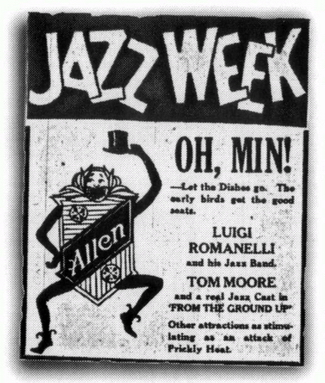
|
|
The Star arranged for three public venues for
listening-in: Riverdale Collegiate Institute, St.
Stevenís Parish Hall at Bellevue and College, and
again at the Christie Street Hospital.
Miss McLean refused to admit any nervousness.
Previous experience in phonograph record work had dulled the sharp
edges of novelty for her. "It gives one a funny
feeling," said Mr. Bilton. "No audience to
look at, you know."
No recording artists appeared on the third concert
in the series, but the fourth, April 12, 1922,
featured Leslie Allen, saxophone, later of the New
Princesí Toronto Band (NPTB; see CAPS' initial
CD release, "Dance Bands from Canada 1922-
1930", CAPS 001).
Leslie Allenís saxophone numbers,
accompanied by Earle Estelle, were a novelty.
The "sobbing saxophone" in "Wabash Blues"
spelled "jazz" with a capital J.
Feet could hardly be restrained from breaking
into a syncopated dance. "When Buddha
Smiles", while more subdued, belonged to the
same family.
"It was a peculiar sensation,Ē said Miss
Maude Buschlen (violinist), as though I were
going to be electrocuted.
I felt as if something might fly at me out of the
horn." ...... Mr. Allen disclaimed nervousness.
Leslie Allen was later a member of several
recorded bands, such as the NPTB in England,
Dave Caplanís Toronto-Band from Canada in
Germany, and with Carroll Gibbons, George
Melachrino and Alfredo and His Band back in
England. In the 1930's, Allen was a huge radio and
recording star with the BBC-Dance Orchestra, and
a rival of the popular Al Bowlly. Leslie Allen was
an uncle of Eddie Allen, singer and accordionist of
the CBCís "Happy Gang".
Frank Wightman's Famous Orchestra. Wightman is at the piano but trumpeter, Alfie Noakes
is not apparent in this photograph. The drummer, at right, could be Gene Fritsley.
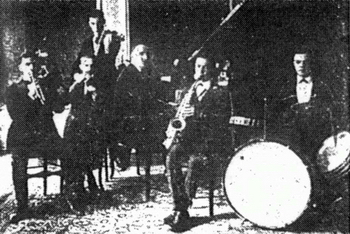
|
|
Luigi von Kunits, the founder of the New
Symphony Orchestra (which became the Toronto
Symphony Orchestra) and teacher of most of the
violin section of the TSO, played on the fifth
broadcast, the Easter program, April 13. Von
Kunits, unfortunately, did not record. By this time
the wooden horn in the CITCo studio had been
replaced by a little fibre funnel which measured
about a foot across.
Concert #6, on April 18, was a popular music night
for dancing to radio syncopation. The regular
announcer was now revealed as Gordon W.
Hogarth of The Toronto Daily Star, and the
broadcast began with the words, "This is radio
station CKCE testing". The program featured
Frank Wightmanís Famous Orchestra (Frank
Wightman, piano; Leslie Chaplin, violin; Alfred
Noakes, trumpet; Wilfred Wheeler, trombone;
Harry Foss, sax and Gene Fritzley, drums). Alfie
Noakes recorded later with the NPTB and with
Alfredo and his Band in London, England.
Eugene Fritzley was a regular in Romanelliís
Orchestra and later recorded with Captain
Plunkettís Overseas Orchestra (see CAPS 001).
Bibliography and credits
- J.E. Atkinson ofthe Star - Ross Harkness,
U of T Press, 1963
- Toronto Daily Star, 1920-1922
- Roll Back the Years - Edward Moogk,
Ottawa, 1975
- Dance Bands from Canada, 1922-1930
(CAPS 001), notes by Colin J. Bray, 2000
- Encyclopedia of Music in Canada (eds.
Kallmann, Potvin & Winters, U of T Press,
1981)
Thanks to Bill Pratt and David Lennick
Arthur E. Zimmerman is author of "In the Shadow
of the Shield" (657 pp), a fully documented oral
history of wireless and radio broadcasting at
Queenís University and in Kingston, Ontario,
1902-1957. He is currently researching the earliest
years of the Montreal and Toronto Marconi radio
stations, XWA/CFCF and CHCB, respectively, and
is looking for biographical information on the
Canadian singers Gus Hill, and Dorothy Lutton, as
well as for copies of the magazine Canadian
Wireless (June 1921-July 1922). He can be
reached by telephone at (416) 923-2001 or by
e-mail at arthurz@look.ca
|